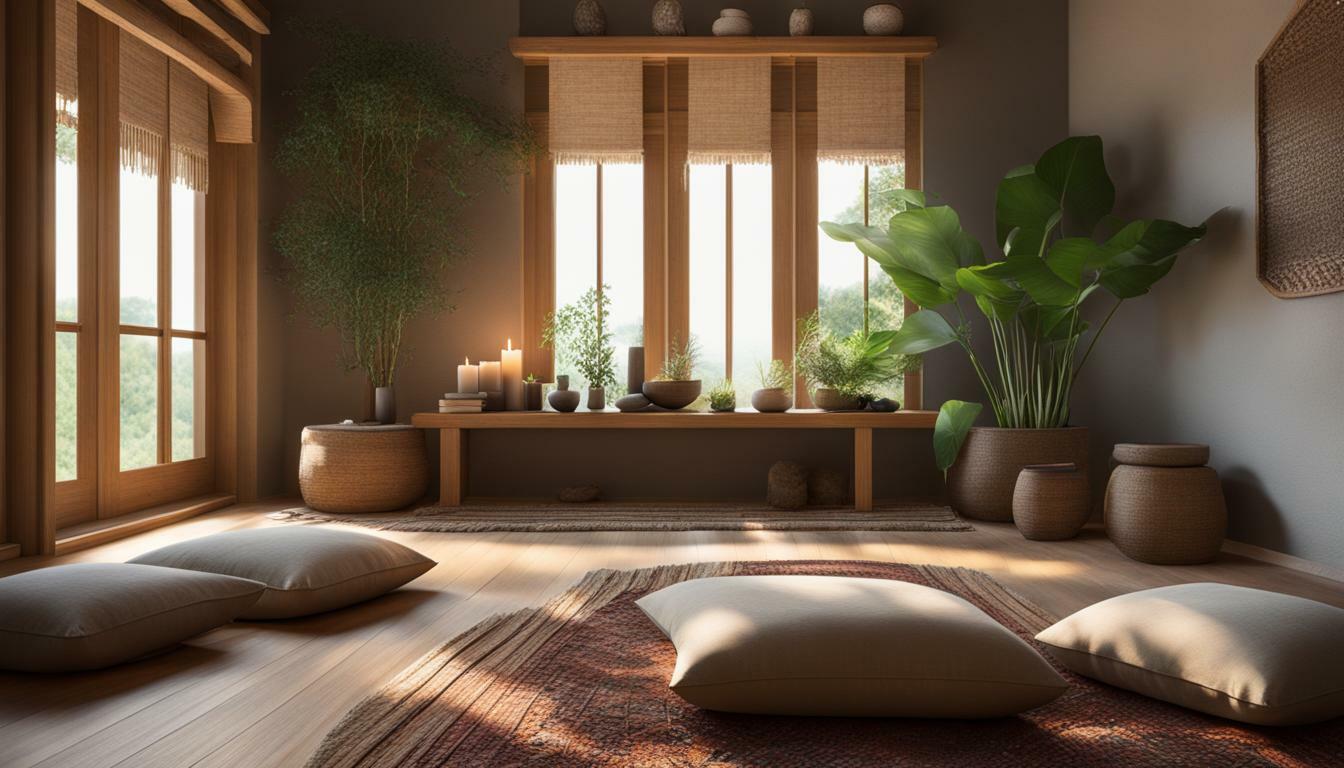Creating a meditation space in your home is a great way to cultivate a sense of calm and relaxation. It provides a dedicated area where you can disconnect from the world and reconnect with yourself. Here are some tips to help you create a soothing meditation space:
Key Takeaways:
- Choose a designated area – Find a corner or room in your home where you can set up your meditation space.
- Keep it simple – Opt for minimalistic furnishings and decor to create a serene and uncluttered environment.
- Incorporate personal touches – Add elements that have meaning to you, such as a joyful Buddha statue or a warm throw blanket.
- Consider natural light – If possible, choose a location with natural light to create a calming and focused atmosphere.
- Create comfort – Make your meditation space cozy and inviting by adding plush pillows, cushions, and blankets.
Now that you have a guide to follow, it’s time to start designing your own meditation space. Remember, this is a personal experience, so feel free to customize it according to your preferences and needs. Embrace the process of creating a tranquil sanctuary that will support your meditation practice and enhance your overall well-being.
Choosing a Designated Area
The first step in creating a meditation space is to choose a designated area in your home where you can find peace and solitude. This area should be free from distractions and provide a sense of tranquility. It can be a small corner of a room or an entire room dedicated to meditation, depending on the space you have available.
Consider the following tips for selecting the perfect location:
- Find a quiet area: Look for a space in your home that is away from noise and foot traffic. This will help you create a serene and peaceful atmosphere.
- Maximize privacy: If possible, choose a location where you won’t be easily disturbed. This can be achieved by selecting a room with a door or using room dividers to create a secluded area.
- Consider natural elements: Try to find a spot with a window that allows natural light to enter. This can help create a calming ambiance. Additionally, if you have a view of nature, such as a garden or trees, it can enhance your meditation experience.
Remember, the goal is to create a space that feels comfortable and inviting, where you can fully relax and connect with your inner self.
| Tip | Description |
|---|---|
| Find a quiet area | Look for a space in your home that is away from noise and foot traffic. This will help you create a serene and peaceful atmosphere. |
| Maximize privacy | If possible, choose a location where you won’t be easily disturbed. This can be achieved by selecting a room with a door or using room dividers to create a secluded area. |
| Consider natural elements | Try to find a spot with a window that allows natural light to enter. This can help create a calming ambiance. Additionally, if you have a view of nature, such as a garden or trees, it can enhance your meditation experience. |
By choosing a designated area for your meditation practice, you are setting the foundation for a harmonious and focused environment that will support your mindfulness journey.
Keeping It Simple
When it comes to your meditation space, simplicity is key. Discover how to create a peaceful atmosphere with minimalistic design elements.
Incorporating minimalistic elements in your meditation space can help create a serene and uncluttered environment that promotes relaxation and mindfulness. Begin by selecting simple cushions, rugs, and furniture that align with your personal taste and preferences. Opt for neutral colors and clean lines to evoke a sense of calmness and tranquility.
Consider decluttering your meditation space by removing unnecessary objects and distractions. Keep only the essentials within reach, such as a meditation cushion, a blanket, and perhaps a small table or shelf to hold items that add meaning to your practice. Embrace the concept of “less is more” and create a space that allows your mind to truly unwind.
Remember, simplicity goes beyond just the physical aspects of your meditation space. It extends to your mindset and approach as well. Let go of expectations and judgments, and instead, focus on being fully present in the moment. Embrace the simplicity of your surroundings and allow yourself to fully immerse in the practice of meditation.
| Key Tips for Keeping It Simple |
|---|
| Declutter: Remove unnecessary objects and distractions from your space. |
| Choose neutral colors: Opt for calming and neutral colors to create a soothing atmosphere. |
| Minimalistic furnishing: Select simple cushions, rugs, and furniture with clean lines. |
| Mindset of simplicity: Embrace the concept of less is more, both physically and mentally. |
By keeping it simple, you can create a meditation space that promotes a deep sense of calm and clarity. As you embark on this journey, remember that your meditation space is highly personal, and it should reflect your unique preferences and needs. Embrace simplicity and allow yourself to fully immerse in the practice of meditation.
Incorporating Personal Touches
Make your meditation space reflect your personality by adding personal touches that bring you joy and tranquility. Customizing your space is an integral part of creating a meditation oasis that truly resonates with you. Here are some meditation room ideas and meditation space organization tips to help you infuse your space with personal touches:
-
Use meaningful decor: Select items that hold significance for you. It could be a favorite painting, a cherished heirloom, or a collection of inspirational quotes. These personal touches can serve as visual reminders of your intentions and help create a serene atmosphere.
-
Add soothing scents: Consider incorporating aromatherapy into your meditation space. Choose essential oils or candles with fragrances that promote relaxation and balance. Lavender, sandalwood, or frankincense are popular choices known for their calming properties.
-
Include sentimental objects: Surround yourself with items that evoke positive emotions. This could be a memento from a meaningful trip, a photo of loved ones, or a musical instrument that you enjoy playing. These objects can anchor you in the present moment and create a sense of emotional connection.
Incorporating personal touches is all about creating a space that speaks to your heart and soul. Experiment with different ideas and be open to exploring what resonates with you the most. Remember, your meditation space is a reflection of your unique journey, so make it a sanctuary that brings you peace and tranquility.
| Benefits of Personal Touches in Your Meditation Space | How to Incorporate Personal Touches |
|---|---|
| “Personalizes your space and makes it truly yours.” | – Add decor that holds meaning for you |
| “Creates a sense of emotional connection and grounding.” | – Include sentimental objects |
| “Enhances the overall meditation experience and promotes relaxation.” | – Use soothing scents |
Considering Natural Light
Natural light can enhance the serenity of your meditation space. Learn how to harness its power and create a peaceful ambiance.
The first step in utilizing natural light is to choose a location for your meditation space that allows plenty of sunshine to pour in. Look for a room with large windows or a nook that receives ample daylight. Position your meditation cushion or chair near the window, so you can bask in the gentle rays of sunlight.
To create a calming atmosphere, consider adding sheer curtains or blinds that allow soft, diffused light to enter the space. This will create a soothing and warm ambiance, perfect for your meditation practice. You can also experiment with different times of the day to find the best light for your meditation sessions.
In addition to natural light, incorporating light-colored or reflective surfaces in your meditation space can help maximize the illumination. Opt for white or light-colored walls, and consider placing mirrors strategically to bounce and distribute light around the room.
Table: Benefits of Natural Light in Meditation Space
| Benefits | Description |
|---|---|
| Enhanced mood | Natural light can improve your mood and overall well-being, helping you feel more positive and energized during meditation. |
| Increased focus | Exposure to natural light can improve concentration and focus, allowing you to dive deeper into your meditation practice. |
| Connection with nature | The presence of natural light creates a stronger connection to the outside world, fostering a sense of calm and grounding. |
| Boosted vitamin D | Exposure to sunlight increases vitamin D production in the body, which plays a vital role in maintaining optimal health. |
Incorporating natural light into your meditation space not only enhances the aesthetics but also creates a peaceful and inviting environment. By harnessing the power of sunlight, you can elevate your meditation practice and experience deeper levels of tranquility and mindfulness.
Creating Comfort
Your meditation space should be a place of comfort and relaxation. Find out how to make it cozy and inviting with plush pillows, cushions, and blankets. Creating a comfortable environment is essential for a truly immersive meditation experience. Here are some tips to help you transform your meditation space into a cozy haven:
- Choose the right cushions and pillows: Opt for cushions and pillows that provide adequate support and cushioning. Look for materials that are soft and breathable, such as cotton or bamboo. Experiment with different sizes and shapes to find what works best for you.
- Add layers of comfort: Layering your meditation spot with blankets and throws can add warmth and coziness. Choose blankets made from natural fibers, like wool or cashmere, for a luxurious touch. You can even incorporate a heated blanket for those chilly meditation sessions.
- Create a designated seating area: Consider setting up a designated seating area with a comfortable chair or a meditation cushion. This will help you establish a dedicated space solely for relaxation and mindfulness.
- Experiment with textures: Incorporate different textures into your meditation space to enhance comfort. Consider adding a soft rug under your seating area or placing a fluffy sheepskin rug over your meditation cushion for added coziness.
Remember, the key to creating comfort is to make your meditation space a reflection of your personal taste and preferences. Surround yourself with items that bring you joy and promote relaxation. Blend practicality with aesthetics to create a space that invites you to unwind and find inner peace.
Quotes
“Comfort is not an option, it is essential when it comes to creating a meditation space. Choose cushions, pillows, and blankets that embrace you with warmth and softness, allowing you to fully immerse into your practice.” – Mindful Living Magazine
By focusing on creating comfort in your meditation space, you are setting yourself up for a more enjoyable and fulfilling meditation practice. So, go ahead and indulge in plush pillows, cushions, and blankets to create a cozy and inviting atmosphere that will help you relax and find tranquility.
| Benefits | How to Achieve Them |
|---|---|
| Enhanced relaxation | Choose soft cushions and pillows that allow your body to sink in comfortably. |
| Improved focus | Create a dedicated seating area with a comfortable chair or a meditation cushion. |
| Increased enjoyment | Experiment with different textures and add layers of comfort with blankets and throws. |
| Deeper mindfulness | Surround yourself with items that bring you joy and promote relaxation. |
Bringing Nature Indoors
Connect with nature within the confines of your meditation space by incorporating elements such as plants, stones, or a small electric water fountain. These natural elements have the power to enhance your meditation practice and create a serene and harmonious environment.
Plants are excellent additions to your meditation space as they not only add a touch of greenery but also purify the air and create a sense of tranquility. Choose plants that are known for their calming properties, such as lavender, jasmine, or aloe vera. Place them strategically around your space to create a calming visual impact and enjoy the soothing fragrance they emit.
Stones and crystals are also wonderful elements to include in your meditation space. Each crystal carries its own unique energy and can help facilitate a deeper state of meditation. Selenite, for example, is believed to promote mental clarity and connection to the divine, while amethyst is said to enhance spiritual growth and relaxation. Arrange your crystals on a small altar or place them around your meditation cushion to harness their energetic properties.
| Plant | Calming Properties |
|---|---|
| Lavender | Relaxation, stress relief |
| Jasmine | Calming, uplifting |
| Aloe Vera | Purifying, healing |
“Incorporating elements of nature into your meditation space can help create a harmonious and peaceful environment, allowing you to connect more deeply with your practice.”
Enjoy the Soothing Sounds of Water
Another way to bring nature indoors is by adding a small electric water fountain to your meditation space. The gentle sound of running water can create a tranquil atmosphere and help drown out any external noise. The soothing sounds of water can induce a sense of calmness and relaxation, making it easier to enter a meditative state.
When choosing a water fountain, opt for one that fits the size and aesthetic of your space. Look for designs that evoke a sense of serenity and choose materials that resonate with you, such as natural stone or ceramic. Place the fountain in a central location within your meditation space, where you can see and hear it during your practice.
By incorporating elements of nature into your meditation space, you can create an environment that promotes mindfulness, relaxation, and a deep connection to the present moment. Experiment with different plants, crystals, and water features to find what resonates with you, and let nature be your guide on your meditation journey.
Conclusion
Creating a meditation space in your home can bring peace and tranquility into your life. Follow these steps and enjoy the benefits of a dedicated sanctuary for your mindfulness practice.
Choose a designated area that suits your needs and preferences. It can be a small nook or an entire room dedicated to meditation. Keep the space simple and uncluttered, using minimalistic furnishings to create a serene environment.
Incorporate personal touches that resonate with you, such as joyful Buddha statues, warm throw blankets, or colorful rugs. Consider the importance of natural light and find a location that maximizes its presence, creating a calming and focused atmosphere.
Make your meditation space comfortable by adding plush pillows, cushions, and blankets. You can also bring elements of nature indoors, such as plants, stones, or a small electric water fountain, to create a harmonious and peaceful environment.
Minimize distractions by removing tech devices and other disturbances from your meditation space. Keep the area clean and uncluttered to promote a clear and calm mind. Lastly, remember to practice meditation regularly and consistently in your designated space to enhance your experience and strengthen your mindfulness practice.
Creating a meditation space is a personal journey, so feel free to customize it according to your preferences and needs. By following these steps, you can create a sacred space that supports your meditation practice and nurtures your overall well-being.
What are some key elements to consider when decorating a meditation room?
When looking to decorate a meditation room, there are essential elements to keep in mind. First and foremost, choose a peaceful color palette that promotes tranquility and relaxation. Incorporate comfortable seating arrangements, such as cushions or a meditation mat. Including natural elements like plants or a small water feature can enhance the calming atmosphere. Lastly, consider incorporating soft and ambient lighting to create a serene ambiance. Choose wisely when you decorate a meditation room.
FAQ
Q: How do I choose a designated area for my meditation space?
A: When selecting a location for your meditation space, find a corner or room in your home where you can set up your space. It can be as simple as a small nook or as elaborate as a dedicated room.
Q: What should I keep in mind when creating a meditation space?
A: When it comes to meditation spaces, less is more. Choose simple cushions, rugs, and furniture to create a serene and uncluttered space.
Q: How can I personalize my meditation space?
A: Add elements that have meaning to you, such as a joyful Buddha statue, a warm throw blanket, or colorful rugs.
Q: Is natural light important for a meditation space?
A: If possible, choose a location with natural light, as it can help create a calming and focused atmosphere.
Q: How can I make my meditation space comfortable?
A: Make sure your meditation space is comfortable by adding plush pillows, cushions, and blankets. You can even use your couch as a meditation spot.
Q: Can I bring nature into my meditation space?
A: Incorporate elements of nature, such as plants, stones, or a small electric water fountain, to create a harmonious and peaceful environment.
Q: Are crystals useful in meditation spaces?
A: Crystals like selenite, clear quartz, and amethyst can enhance your meditation practice. Place them around your meditation space or hold them in your hands during meditation.
Q: Should I remove distractions from my meditation space?
A: Remove tech devices and other distractions from your meditation space to create a peaceful and focused atmosphere.
Q: How should I maintain my meditation space?
A: Keep your meditation space clean and uncluttered to promote a clear and calm mind.
Q: How often should I practice meditation in my designated space?
A: Practice meditation regularly and in the same place to improve your experience and strengthen your mindfulness practice.








